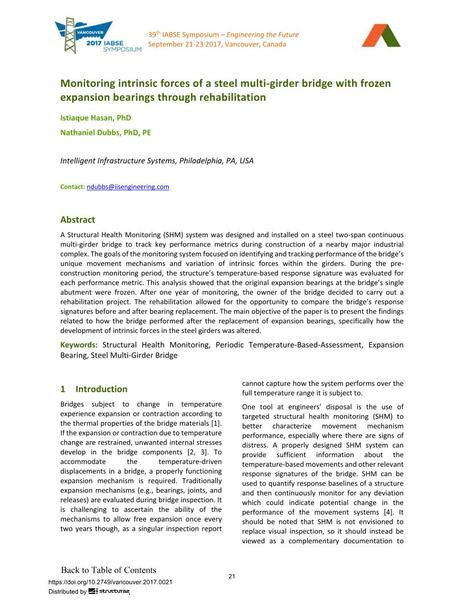Monitoring intrinsic forces of a steel multi-girder bridge with frozen expansion bearings through rehabilitation

|
|
|||||||||||
Détails bibliographiques
| Auteur(s): |
Istiaque Hasan
(Intelligent Infrastructure Systems, Philadelphia, PA, USA)
Nathaniel Dubbs (Intelligent Infrastructure Systems, Philadelphia, PA, USA) |
||||
|---|---|---|---|---|---|
| Médium: | papier de conférence | ||||
| Langue(s): | anglais | ||||
| Conférence: | IABSE Symposium: Engineering the Future, Vancouver, Canada, 21-23 September 2017 | ||||
| Publié dans: | IABSE Symposium Vancouver 2017 | ||||
|
|||||
| Page(s): | 21-28 | ||||
| Nombre total de pages (du PDF): | 8 | ||||
| Année: | 2017 | ||||
| DOI: | 10.2749/vancouver.2017.0021 | ||||
| Abstrait: |
A Structural Health Monitoring (SHM) system was designed and installed on a steel two‐span continuous multi‐girder bridge to track key performance metrics during construction of a nearby major industrial complex. The goals of the monitoring system focused on identifying and tracking performance of the bridge’s unique movement mechanisms and variation of intrinsic forces within the girders. During the pre‐ construction monitoring period, the structure’s temperature‐based response signature was evaluated for each performance metric. This analysis showed that the original expansion bearings at the bridge’s single abutment were frozen. After one year of monitoring, the owner of the bridge decided to carry out a rehabilitation project. The rehabilitation allowed for the opportunity to compare the bridge’s response signatures before and after bearing replacement. The main objective of the paper is to present the findings related to how the bridge performed after the replacement of expansion bearings, specifically how the development of intrinsic forces in the steel girders was altered. |
||||
